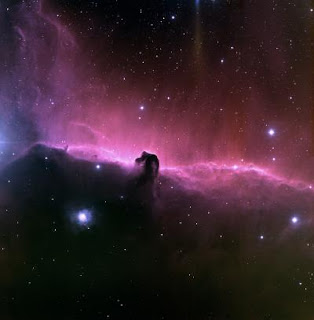Both America's Astronomical League (AL) and Canada's Royal Astronomical Society (RASC) have observing programs for Dark Nebulae, and each plan is available in the Deep-Sky Planner Plan Library. Each program has very helpful information available to help with observing. See https://www.astroleague.org/al/obsclubs/DarkNebulaeClub if you are pursuing the AL program, or the RASC Observer's Handbook if you are pursuing the Canadian one.
The objects in these plans typically come from E.E. Barnard's photographic survey of dark nebulae (1927), or from B.T. Lynds' more recent survey (1962) based on the Palomar Observatory Sky Atlas images. These catalogs list size estimates, and the Lynds catalog includes a ranking of darkness - again note that magnitude data are not applicable!
 |
| Horsehead Nebula T.A.Rector (NOAO/AURA/NSF) and Hubble Heritage Team (STScI/AURA/NASA) |
This is a particularly favorable time of year to observe dark nebulae as many lie along the northern hemisphere's summer Milky Way. Although many lie in the summer sky, dark nebulae are visible throughout the year. For example, B 33/LDN 1630 - the Horsehead Nebula - is visible in northern hemisphere's winter evenings. To observe dark nebulae successfully, you need a very dark sky and very well dark-adapted eyes. Some objects can be observed with binoculars, but most require a telescope. The Great Rift in Cygnus and Aquila can be observed with the unaided eye.
Observing dark nebulae can be a nice change of pace from observing bright nebulae, galaxies and clusters. Why not give them a try using one of the observing plans available from the Plan Library?